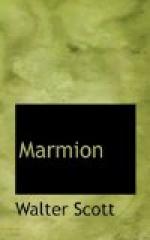line 453. ave, an address to the Virgin Mary, beginning ‘Ave Maria’; creed, a profession of faith, beginning with Credo. It has been objected to this line that the creed is not an essential part of the rosary, and that ten aves and one paternoster would have been more accurate. It should, however, be noticed that both Friar John and young Selby know more of other matters than the details of religious devotion.
Stanza xxvii. line 459. ’A Palmer, opposed to a pilgrim, was one who made it his sole business to visit different holy shrines; travelling incessantly, and subsisting by charity: whereas the Pilgrim retired to his usual home and occupations, when he had paid his devotions at the particular spot which was the object of his pilgrimage. The Palmers seem to have been the Quaestionarii of the ancient Scottish canons 1242 and 1296. There is in the Bannatyne Ms. a burlesque account of two such persons, entitled, “Simmy and his Brother.” Their accoutrements are thus ludicrously described (I discard the ancient spelling):—
“Syne shaped them up, to
loup on leas,
Two tabards of the tartan;
They counted nought what their clouts were
When sew’d them on, in certain.
Syne clampit up St. Peter’s keys,
Made of an old red gartane;
St. James’s shells, on t’other side,
shews
As pretty as a partane
Toe,
On Symmye and his brother."’—Scott.
With this account of the Palmer, cp. ‘Piers the Plowman,’ v. 523:—
’He bare a burdoun ybounde . with a brode liste,
In a withewyndes wise . ywounden aboute.
A bolle and a bagge . he bare by his syde;
An hundredth of ampulles . on his hatt seten,
Signes of Synay . and shelles of Galice;
And many a cruche on his cloke . and keyes of Rome,
And the vernicle bifore . for men shulde knowe,
And se bi his signes . whom he soughte hadde.’
In connexion with this, Prof. Skeat draws attention to the romance of Sir Isumbras and to Chaucer’s Prol. line 13.
line 467. Loretto, in Ancona, Italy, is the site of a sanctuary of the Virgin, entitled Santa Casa, Holy House, which enjoys the reputation of having been the Virgin’s residence in Nazareth, and the scene of the Annunciation, &c.
Stanza xxviii. line 483. haggard wild is a twofold adj. in the Elizabethan fashion, like ‘bitter sweet,’ ‘childish foolish,’ and other familiar examples.
line 490. Science appears to support this theory. See various examples in Sir Erasmus Wilson’s little work, ‘Healthy Skin.’ Many of the cases are within the writer’s own knowledge, and all the others are historical or otherwise well authenticated. He mentions Sir T. More the night before his execution; two cases reported by Borellus; three by Daniel Turner; one by Dr. Cassan; and in a note he recalls John Libeny, a would-be assassin of the Emperor of Austria, ’whose hair turned snow-white in the forty-eight hours preceding his execution.’ See ‘Notes and Queries,’ 6th S. vols. vi. to ix., and 7th S. ii. Not only fear but sorrow is said to cause the hair to turn white very suddenly. Byron makes his Prisoner of Chillon say that his white hairs have not come to him




